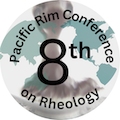Speaker
Description
Abstract:
Yield stress fluids are often thought about in a piecewise manner as behaving like elastic solids below the yield stress and like generalized Newtonian liquids above it. Accurate determination of the yield stress is therefore crucial to understanding and predicting the behaviour of yield stress fluids such as inks for 3D printing, foods and cosmetics, muds and soils, and many industrially and biologically relevant materials. Despite the centrality of the yield stress concept, there exist multiple methods by which researchers determine ‘the’ yield stress, and they can provide values that are orders of magnitude apart. Such discrepancies have even led to some asking the question of whether the yield stress exists at all.
In this work we study a series of yield stress fluids using recovery rheology concepts, where strain is decomposed into recoverable and unrecoverable components, and present evidence that yielding takes place gradually over a wider range of stresses than previously thought. It is shown that the overshoot in the loss modulus that has often been used as a measure of yielding is due to the acquisition of unrecoverable strain. It’s shown how these measurements led to the development of a model that describes spatially heterogeneous yielding in a mean-field manner and how accurately this model predicts the rheology of simple yield stress fluids.
In more complex materials, responses are observed with two overshoots in the loss modulus, a phenomenon often referred to as “double yielding”. It is shown that these dual features are really a combination of two distinct processes, only one if which is yielding. New protocols inspired by recovery concepts are also used to show that small amounts of flow occur below the yield stress determined by a Herschel-Bulkley fit to steady-shear flow measurements in a predictable manner as a function of stress amplitude, angular frequency, and applied stress phase angle. Relations are presented that show how these measures can be used to determine the contribution to the loss modulus from unrecoverable plastic deformations, providing some of the same information as the full iteratively performed recovery tests, but in a fraction of the time.
Recovery rheology therefore adds nuance to our understanding of yield stress fluids by highlighting the continuous nature of yielding and providing a general set of methods by which reliable and consistent yielding information can be rapidly obtained.
Bio: Simon A. Rogers is an Associate Professor in the Department of Chemical and Biomolecular Engineering, University of Illinois at Urbana-Champaign, USA. Dr. Rogers uses experimental and computational tools to understand and model advanced colloidal, polymeric, and self-assembled materials. He received his BSc in 2001, BSc (Hons) in 2002; and his PhD from Victoria University of Wellington in New Zealand in 2011. He completed his postdoctoral research at the Foundation for Research and Technology in Crete, the Jülich Research Center in Germany, and the Center for Neutron Research at the University of Delaware.

